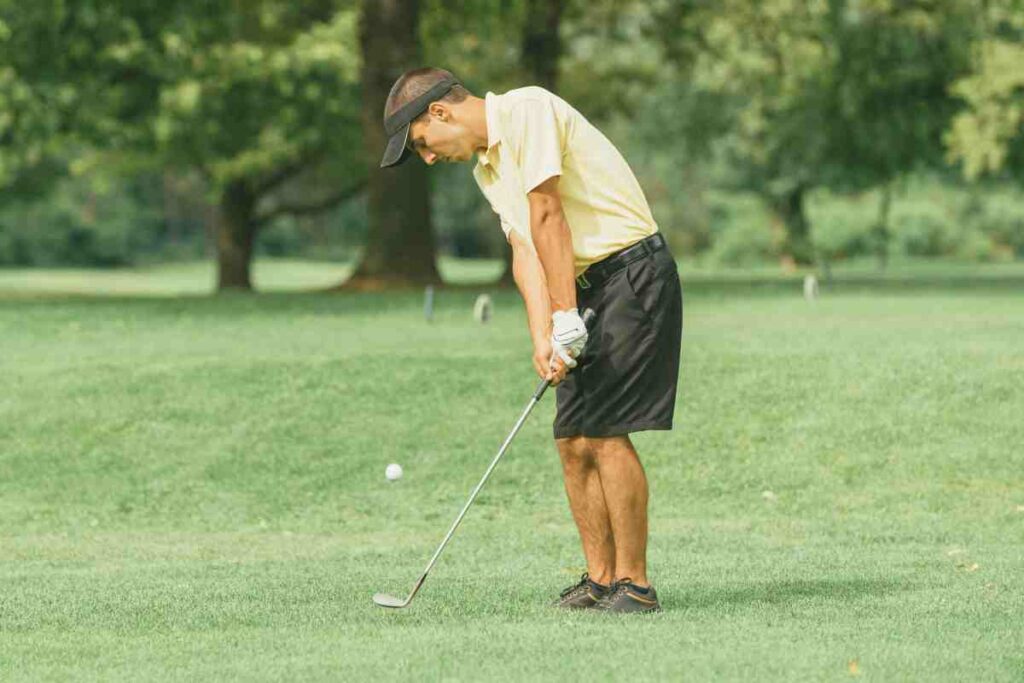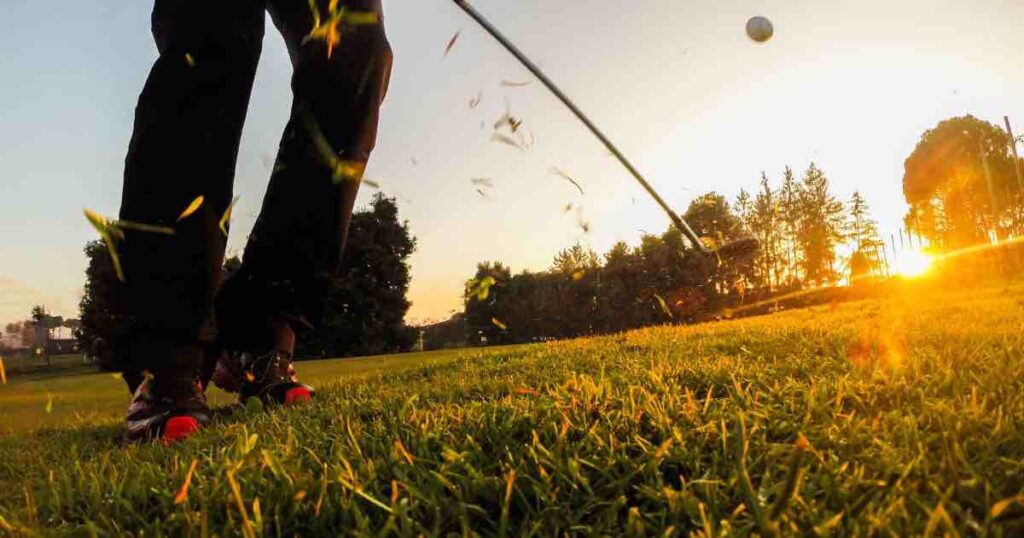Every proper golf swing begins with the correct golf stance. Your golf stance is instrumental in determining the success of your shot. A golf swing involves complex body mechanics, and the stance is critical in facilitating an effective swing motion. This post will explore the fundamentals of a sound golf stance, how it should adjust for different clubs and shots, and helpful drills to perfect it.
Setting a Good Swing Foundation

A proper golf stance is critical for several reasons. Firstly, it sets the stage for the swing path and the clubface’s orientation at impact. Both of which are key factors in the ball’s flight direction and distance. You may struggle to hit the ball straight or achieve your desired distance without a correct stance.
Secondly, a good stance promotes balance and stability. Golf swings generate a lot of power and torque. Using a proper stance maintains balance throughout the swing, enabling you to strike the ball more consistently.
Finally, a proper golf stance allows for better control over the club during the swing. This increased control improves accuracy, allowing you to hit more fairways and greens during your round.
The Elements of a Golf Stance
A golf stance refers to how you position your body in preparation for your golf swing. The setup precedes every shot and is as integral to the swing as the movement itself. A proper golf stance involves the key elements of alignment, posture, balance, and stance width.
Alignment
Alignment is about positioning your body and club in relation to your target. When properly aligned, your feet, hips, and shoulders should be parallel to the target line – an imaginary line extending from the ball toward the target. Incorrect alignment can lead to off-target shots and compensatory swing flaws.
Posture
A good golf posture involves bending from the hips while keeping the back straight and allowing a slight knee flex. This position provides for a free torso rotation during the swing, promoting power and consistency. Conversely, poor posture can restrict this rotation, leading to a loss of power and accuracy.
Balance
Balance in a golf stance refers to the distribution of your body weight. At address, you should have your weight distributed evenly between your left and right foot and slightly favoring the balls of your feet. This promotes stability during the swing and helps maintain consistent contact with the ball.
Stance Width
Subsequently, the width of your stance — the distance between your feet — impacts your balance and the rotation of your body during the swing. Generally, your feet should be shoulder-width apart for mid-irons, slightly wider for longer clubs, and narrower for shorter clubs.
Arm and Hand position
The correct arm, hand and grip position allow you to achieve the right distance to the golf ball in your stance. Your arms should hang down naturally without reaching out to make contact with the ball. Typically, the club should touch around 1 inch above your kneecap. If this doesn’t happen, you may need to adjust your distance to the golf ball. When you take your setup, drop your trail hand off the club. If your hand swings away from the grip and towards your body, it indicates you’re standing too far from the ball. A good rule of thumb is to have the butt of the club point at your belt buckle and be about 6 inches away from your body.
Proper Golf Stance for Each Club
Every club in your bag — from the driver to the wedges — has a unique design and purpose. Therefore, each require subtle adjustments in your stance to cater to its length, loft, and intended use. The driver, designed for distance, needs a different approach than a short iron designed for accuracy. Similarly, a wedge used for precise shots around the green demands a more nuanced stance.
These variations in stance are necessary to achieve the optimal angle of attack, ball flight, and distance for each club. Understanding these differences and adjusting your stance can enhance your control over the ball. As a result, you will improve consistency, accuracy, and distance across all clubs.
Golf Stance for Driver
Adjusting your golf stance for a driver is a crucial part of maximizing your performance off the tee. It involves a unique setup compared to other clubs in your bag. A driver requires specific attention to stance width, ball position, and shoulder tilt. Given the length of the driver and its design for distance, a proper driver stance helps optimize for power, stability, and an upward strike on the ball.
Stance Width
With a driver, your feet should be slightly wider than shoulder-width apart. A wider stance provides a more stable base for your swing, allowing you to maintain balance as you generate high clubhead speed. It also enables a more significant body rotation, delivering more power to drive the ball further.
Ball Position
In a driver stance, the ball is positioned near your front foot, typically aligned with the inside of your front heel. This forward ball position promotes an upward angle of attack, helping you to “get underneath” the ball. Striking the ball on the upswing is vital for maximizing distance with a driver, as it helps launch the ball higher with less backspin.
Shoulder Tilt
When addressing the ball with a driver, it’s essential to have a slight tilt in your shoulders, with the back shoulder lower than the front shoulder. This shoulder tilt aligns your upper body with the upward angle of attack. It also helps to keep your spine behind the ball through impact, which is critical for generating force and striking the ball effectively.
Golf Stance for Irons and Hybrids
Irons and hybrids are should strike with a descending blow. This means the clubhead should connect with the ball before continuing down into the turf. Therefore, your stance should promote this downward strike, rather than the upward strike in the driver stance.
Stance Width
With irons and hybrids, a shoulder-width stance is recommended. This provides a solid base for your swing while allowing enough mobility to rotate your body effectively. A shoulder-width stance also promotes a more upright swing plane, suitable for the shorter length of these clubs compared to a driver.
Ball Position
The ball position varies slightly between irons and hybrids, and even among different types of irons. As a general rule, the ball should be directly in the middle of your stance for short irons, slightly forward of center for mid-irons, and just inside your front heel for long irons and hybrids.
These variations in ball position accommodate the different club lengths and loft angles. This helps you achieve the correct angle of attack for each shot. For instance, a more central ball position with short irons helps promote a steep angle of attack, ideal for generating high, accurate shots with more backspin. Conversely, a forward ball position with hybrids and long irons promotes a shallower angle of attack, producing longer, more penetrating ball flights.
Golf Stance for Wedges
The wedge stance is a central component of successful short-game play. Golf Wedges are typically used for shorter, more precise shots, so the stance differs from those used with drivers, irons, or hybrids. The key characteristics of a proper wedge stance include a narrower stance width and specific ball positioning.
Stance Width
A narrower stance is needed when using a wedge. This setup involves aligning your feet closer together than you would with longer clubs by an inch or two. A narrower stance encourages a steeper swing path, which is desirable with wedge shots as it helps to strike the ball cleanly off various lies. This steeper attack angle and the high loft of wedges also promote a higher trajectory and more backspin. Both of which help you stop the ball quickly on the green.
Ball Positioning
The ball position in a wedge stance typically leans towards the back foot. Although, this will vary depending on the type of shot you’re playing. For standard wedge shots, having the ball positioned in the middle of your stance or slightly back from center can help ensure a downward strike on the ball, maximizing spin and control.
For shots that require more loft, such as a flop shot, the ball can be positioned towards the front foot to encourage a higher launch. Conversely, the ball can be placed back in the stance for low-running shots. More on this in the next section.
Golf Stance For Various Wedge Shots

In golf, each shot can present you with its own unique challenges. As such, your stance will often need to be adjusted based on the type of shot you’re attempting. Understanding these variations can significantly improve your ability to execute different shots effectively.
Chip Shots
A chip shot is a low-trajectory shot typically used when you are close to the green. The goal is to get the ball in the air briefly before letting it roll towards the hole. Chipping requires precision and control. The aim is to get the ball as close to the pin as possible, if not in the hole.
Stance Adjustment for Chip Shots
When preparing to hit a chip shot, several adjustments should be made to your stance to promote the desired ball flight and control.
- Narrow Stance: A narrow stance is recommended for chip shots. This helps to limit body movement and encourages a more vertical swing path, which is desirable for clean, crisp contact.
- Ball Position: For most chip shots, the ball position is towards the back foot. This helps encourage a downward strike on the ball, which is crucial for achieving the necessary loft and spin.
- Weight Distribution: It’s also important to lean slightly towards your front foot, with about 60-70% of your weight on that side. This weight distribution promotes a downward strike and helps prevent hitting the ground before the ball.
- Foot Orientation: Some golfers find opening their front foot towards the target helpful, encouraging a complete follow-through and helping to guide the ball towards the intended target.
Pitch Shots
A pitch shot in golf is played with a highly lofted club and travels a relatively short distance with a steep ascent and descent. Pitch shots spend more time in the air than on the ground, featuring a higher trajectory and more spin. They are typically used when you must go over an obstacle, such as a bunker, or when you’re too far from the green for a chip shot but too close for a full swing. Pitch shots can be played from longer distances up to around 30 yards.
Stance Adjustment for Pitch Shots
When preparing to hit a pitch shot, here are the adjustments you should make to your golf stance.
- Open Stance: An open stance, where your front foot is pulled back from the target line, can benefit pitch shots. This setup helps to promote an outside-in swing path, ideal for creating the loft and spin necessary for a successful pitch shot.
- Ball Position: The ball position is in the center of your stance or slightly forward. This allows for a steeper angle of attack, which is crucial for achieving the necessary loft and spin.
- Weight Distribution: Similar to chip shots, it’s also important to lean slightly towards your front foot, with about 60-70% of your weight on that side. This weight distribution promotes a downward strike and helps prevent hitting the ground before the ball.
- Hands Position: Your hands should be slightly ahead of the ball at address. This helps to ensure a clean, crisp contact and promotes the high trajectory necessary for a pitch shot.
Lob Shots
A lob shot in golf is a high-trajectory, short-distance stroke designed to stop quickly upon landing. It is often used when the player needs to get over an obstacle, such as a bunker or even another player’s ball, and stop the ball on a tight pin location with little green to work with. The lob shot, also called a flop shot, is one of the most challenging shots in golf due to its requirement for precision and delicate touch.
Stance Adjustment for Lob Shots
Executing a successful lob shot requires specific adjustments to your stance.
- Open Stance: Similar to pitch shots, a slightly open stance benefits lob shots. This setup promotes an outside-in swing path necessary for creating a lob shot’s high loft and spin characteristic.
- Ball Position: The ball position is towards the front of your stance. This positioning encourages a high launch angle, allowing the ball to get up into the air quickly.
- Weight Distribution: While many short game shots require leaning towards your front foot, a lob shot requires a more balanced weight distribution. This helps to shallow out the angle of attack, which is crucial for achieving the high trajectory of a lob shot.
- Clubface Position: The clubface should be opened up at the address, almost facing the sky. This increases the effective loft of the club, helping to create the necessary height for a lob shot.
Remember, lob shots are high-risk high-reward and should be used sparingly when other, more straightforward shots will do. But with practice and these stance adjustments, you can add this valuable shot to your golfing arsenal.
Bunker Shots
Bunker shots, or sand shots, are golf strokes played from a sand trap or “bunker” on the course. These shots can be challenging due to the unstable footing and the need to hit the ball out of the sand rather than off the turf. The objective is to loft the ball high enough that it clears the lip of the bunker while also controlling its distance so that it lands softly on the green.
Stance Adjustment for Bunker Shots
When hitting a bunker shot, you will want to make these specific adjustments to your stance to see success in getting out of the sand.
- Open Stance: An open stance is beneficial for bunker shots, similar to lob shots. This setup helps you swing along the line of your feet and promotes an outside-in swing path, which is necessary for escaping the bunker.
- Ball Position: The ball should be positioned up in your stance, closer to your front foot. This positioning allows for a higher launch angle and helps ensure the clubhead enters the sand before the ball, which is crucial for a successful bunker shot.
- Weight Distribution: Unlike other shots, where your weight might lean towards your front foot, in a bunker shot, you want to have your weight evenly distributed or slightly favoring your back foot. This helps to prevent digging too deep into the sand.
- Foot Digging: In a bunker, it’s important to dig your feet into the sand slightly. This provides stability and gives you a feel for the texture of the sand, which can impact how the ball reacts.
- Clubface Position: At address, the clubface should be opened up. This increases the effective loft of the club, aiding in getting the ball up and out of the sand.
With these stance adjustments and a bit of practice, bunker shots can become less intimidating and more manageable.
Golf Tips & Drills to Work on Your Golf Stance
- Mirror Drill: Stand in front of a mirror and practice setting up with the correct posture. This can help you get a feel for how the ideal position looks.
- Alignment Stick Drill: Lay an alignment stick on the ground pointing at your target, then set up parallel to it. This will help improve your alignment and get a feel for the proper aim.
- Ball Position Drill: Practice setting up with the ball in different positions in your stance (back, middle, forward) and notice how it affects the ball’s flight.
- Towel Drill: Place a small towel under your arms and make swings without letting it drop. This can help improve your connection and prevent you from trying to lift the ball.
- Quick Golf Posture Drill: This drill assists in getting into the right spine position, an essential element of a good golf stance. Stand straight with a club along your spine, ensuring the club touches your tailbone and the back of your head. Bend from the hips until the club leaves the back of your head, then flex your knees slightly. This should give you a sense of the correct spine position over the ball.
Final Thoughts on the Proper Golf Stance
A correct and consistent stance sets the foundation for a successful golf swing, enabling better control, accuracy, and distance in your shots. It’s the starting point of every stroke, from drives to chips, and plays a crucial role in being able to execute your shots.
However, all golfers are different, and finding a stance that works best for you may require some adjustment and fine-tuning. Avoid common mistakes such as poor posture, incorrect ball position, and improper alignment. Golf is a game of continuous improvement. Even the most seasoned professionals spend countless hours practicing and refining their stances and swings. With persistence and practice, you can adopt the proper golf stance and see noticeable improvements in your game.




